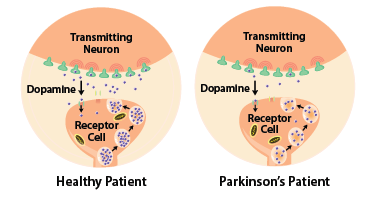Parkinson's Disease: Difference between revisions
No edit summary |
No edit summary |
||
| (11 intermediate revisions by 5 users not shown) | |||
| Line 1: | Line 1: | ||
Parkinson’s disease, also known as hypokinetic rigid syndrome (HRS), is an [[Idiopathic|idiopathic]] and | Parkinson’s disease, also known as hypokinetic rigid syndrome (HRS), is an [[Idiopathic|idiopathic]] and is a degenerative disorder. This condition predominantly affects the part of the nervous system related to movement. It is normally due to the degeneration of [[Dopaminergic neurone|dopaminergic neurones]] of the nigrostriatal tract and loss of [[Dopamine|dopamine]] (DA) neurotransmission in the striatum. The symptoms of this disease are a resting tremor, muscle rigidity, suppression of voluntary movements (hypokinesis) and postural instability. Another common symptom of parkinsons</span><span style="font-size: 13.28px;"> disease is freezing which is the inability to move temporarily and can last a few seconds to several minutes. Often people feel like their feet are stuck to the ground and this occurs often when a sufferer is carrying out repetitive movements like walking, eating or writing.</span> | ||
[[Image:Parkinsons patients have less dopamine.png|right|Dopamine in Parkinson's Disease]] | |||
In the later stages, mental and behavioural symptoms may occur such as anxiety, depression, anosmis, difficulty sleeping and even things such as dementia. | |||
The main 4 dopaminergic pathways are:- | The main 4 dopaminergic pathways are:- | ||
#<span style="line-height: 1.5em | #<span style="line-height: 1.5em">[[Nigrostriatal pathway|Nigrostriatal]] - </span>Substantia nigra to [[Striatum|striatum]] | ||
#[[Striatum|Striatum]] | #[[Striatum|Striatum]] <span style="line-height: 1.5em">Mesolimbic - </span>Ventral tegmental area to nucleus accumbens | ||
#<span style="line-height: 1.5em | #<span style="line-height: 1.5em">Mesocortical - </span>Ventral tegmental area to [[Frontal cortex|frontal cortex]] | ||
#[[Frontal cortex|Frontal cortex]] | #[[Frontal cortex|Frontal cortex]] <span style="line-height: 1.5em">Tuberoinfundibular - </span>Arcuate nucleus to [[Pituitary gland|pituitary gland]] | ||
=== Treatments === | |||
The [[Decarboxylase inhibitor|decarboxylase inhibitor]] – carbidopa, the </span>[[MAO|MAO inhibitor]]<span style="line-height: 1.5em">: Selegiline and </span>[[D2 receptor|D2 receptor agonists]]<span style="line-height: 1.5em"> like [[Bromocriptine|Bromocriptine]] can be used to treat Parkinson’s disease. | |||
</span> | |||
L-DOPA is a drug often given to patients in early stages of Parkinson's disease to suppress symptoms. L-DOPA is converted to dopamine in the brain, therefore, increasing the amount available to bind to dopamine receptors<ref>Picture reference: Parkinsons Disease. National Institue of Environmental Health Sciences. Available from: http://www.niehs.nih.gov/health/topics/conditions/parkinson/ </ref><ref>http://www.nhs.uk/Conditions/Parkinsons-disease/Pages/Introduction.aspx</ref>. | |||
[[D2 receptor agonists|D2 receptor agonists]], such as [[Bromocriptine|Bromocriptine]] and Cabergoline, are also prescribed to sufferers of Parkinson's disease. D2 receptor agonists, unlike L-DOPA, actually mimic [[Dopamine|dopamine]]. This, therefore, reduces the symptoms that patients with Parkinson's disease experience, a major one being [[Bradykinesia|bradykinesia]]. There are more known side effects associated with [[D2 receptor agonists|D2 receptor agonists]] compared to L-DOPA and so L-DOPA is more commonly prescribed to patients<ref>Health Talk. Dopamine receptor agonists. 2016 [cited 1/12/16]; Available from http://www.healthtalk.org/peoples-experiences/nerves-brain/parkinsons-disease/dopamine-receptor-agonists</ref>. | |||
Additionally, sufferers of Parkinson's disease can receive [[Physiotherapy|physiotherapy]] to reduce the severity of their motor symptoms. Physiotherapists can introduce the patient to a wide range of exercises which can strengthen their [[Muscles|muscles]] and improve flexibility. Manual physiotherapy involves massaging different regions of the body to stimulate movement<ref>National Parkinson Foundation. Understanding Parkinsons. 2016 [cited 1/12/16]; Available from http://www.parkinson.org/understanding-parkinsons</ref>. | |||
=== References === | |||
< | <references /> | ||
Latest revision as of 17:10, 26 October 2017
Parkinson’s disease, also known as hypokinetic rigid syndrome (HRS), is an idiopathic and is a degenerative disorder. This condition predominantly affects the part of the nervous system related to movement. It is normally due to the degeneration of dopaminergic neurones of the nigrostriatal tract and loss of dopamine (DA) neurotransmission in the striatum. The symptoms of this disease are a resting tremor, muscle rigidity, suppression of voluntary movements (hypokinesis) and postural instability. Another common symptom of parkinsons disease is freezing which is the inability to move temporarily and can last a few seconds to several minutes. Often people feel like their feet are stuck to the ground and this occurs often when a sufferer is carrying out repetitive movements like walking, eating or writing.

In the later stages, mental and behavioural symptoms may occur such as anxiety, depression, anosmis, difficulty sleeping and even things such as dementia.
The main 4 dopaminergic pathways are:-
- Nigrostriatal - Substantia nigra to striatum
- Striatum Mesolimbic - Ventral tegmental area to nucleus accumbens
- Mesocortical - Ventral tegmental area to frontal cortex
- Frontal cortex Tuberoinfundibular - Arcuate nucleus to pituitary gland
Treatments
The decarboxylase inhibitor – carbidopa, the </span>MAO inhibitor: Selegiline and D2 receptor agonists like Bromocriptine can be used to treat Parkinson’s disease.
L-DOPA is a drug often given to patients in early stages of Parkinson's disease to suppress symptoms. L-DOPA is converted to dopamine in the brain, therefore, increasing the amount available to bind to dopamine receptors[1][2].
D2 receptor agonists, such as Bromocriptine and Cabergoline, are also prescribed to sufferers of Parkinson's disease. D2 receptor agonists, unlike L-DOPA, actually mimic dopamine. This, therefore, reduces the symptoms that patients with Parkinson's disease experience, a major one being bradykinesia. There are more known side effects associated with D2 receptor agonists compared to L-DOPA and so L-DOPA is more commonly prescribed to patients[3].
Additionally, sufferers of Parkinson's disease can receive physiotherapy to reduce the severity of their motor symptoms. Physiotherapists can introduce the patient to a wide range of exercises which can strengthen their muscles and improve flexibility. Manual physiotherapy involves massaging different regions of the body to stimulate movement[4].
References
- ↑ Picture reference: Parkinsons Disease. National Institue of Environmental Health Sciences. Available from: http://www.niehs.nih.gov/health/topics/conditions/parkinson/
- ↑ http://www.nhs.uk/Conditions/Parkinsons-disease/Pages/Introduction.aspx
- ↑ Health Talk. Dopamine receptor agonists. 2016 [cited 1/12/16]; Available from http://www.healthtalk.org/peoples-experiences/nerves-brain/parkinsons-disease/dopamine-receptor-agonists
- ↑ National Parkinson Foundation. Understanding Parkinsons. 2016 [cited 1/12/16]; Available from http://www.parkinson.org/understanding-parkinsons